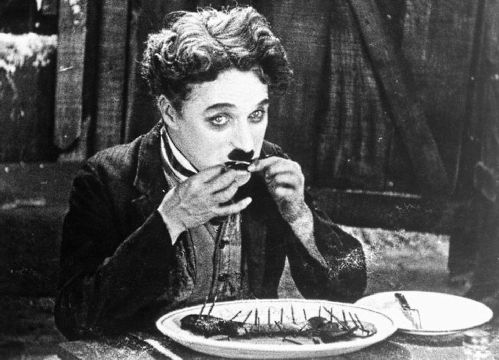The Gold Rush (1925) 

Director: Charles Chaplin
Cast: Charles Chaplin, Mack Swain, Tom Murray
Synopsis: The Tramp goes to the Klondike in search of gold and finds it and more.
Chaplin’s Little Tramp had undergone quite a change in the eleven years between his first appearance and The Gold Rush. The spiteful, mean-spirited soul prone to kicking all who displeased him in the backside had evolved into a much more sympathetic character, invested with a large degree of pathos and sentimentality. He was now more likely to be the innocent victim of the unjust wrath of others than to be the one handing out the violence. The Gold Rush offers a clear example of this transformation, with the Tramp suffering all manner of abuse before finally coming out on top.
The Gold Rush is set during the Klondike gold rush in the late 1800s. We first meet the little tramp – credited here as the lone prospector – as he blithely traverses perilously narrow mountain-side pathways. He’s untroubled by the physical hardship his fellow prospectors struggle to endure, because it’s the affairs of the heart that trouble our hero. Following his arrival in a prospecting town after surviving a hair-raising stay in a stormbound cabin during which his hallucinating cabin mate, believing Charlie to be a giant chicken, tried to eat him, he falls for the charms of bar girl Georgia (Georgia Hale). But Georgia merely uses him as a convenient means of showing her contempt for big Jack (Malcolm Waite) and his unwanted advances.
Considered by Chaplin to be his finest work, The Gold Rush does still hold up as a fine example of the sophistication of Chaplin’s craft. The physical comedy is slick and perfectly timed, the former slapstick replaced by a smooth choreography. In fact the physical element isn’t particularly prominent in The Gold Rush, despite the scope provided by the locations and situations. Chaplin’s determination to make his character the audience’s darling left little room for slapstick, and instead we are treated to such sublime set pieces as Chaplin and Mack Swain sharing a boot for dinner (Chaplin wears a thick cloth wound around his foot for all the subsequent scenes) and the timeless dance of the rolls.
He was probably right to consider The Gold Rush his best work. The cloying sentimentality that tainted parts of his later movies was kept in check, allowing us to empathise with the little man on our own terms without feeling like we’re being prodded in the back to do so. Fans should steer clear of the 1942 re-release, however, for which Chaplin added a new musical score and provided an irritatingly inappropriate and unnecessary voiceover to replace the original intertitles.
(Reviewed 2nd July 2012)
httpv://www.youtube.com/watch?v=UDhQddBZTUs
